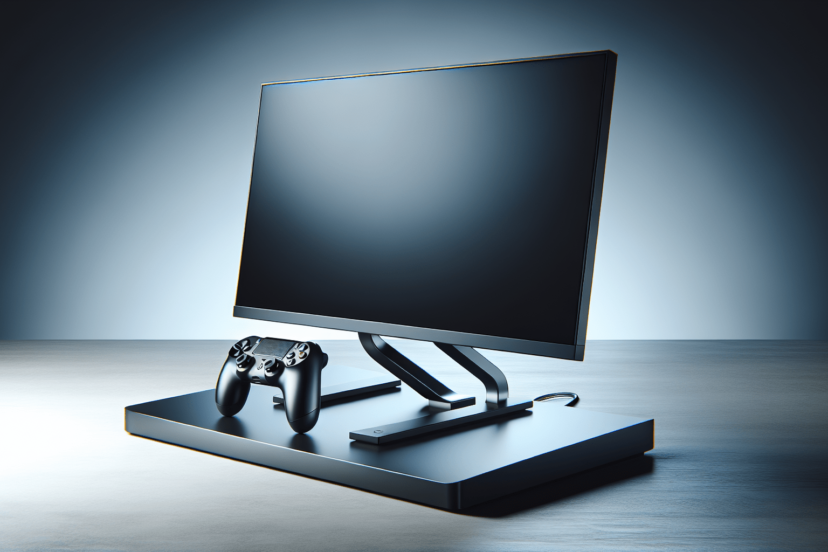How Do I Choose A Monitor For Console Gaming?
Are you a console gamer looking for the perfect monitor to enhance your gaming experience? Look no further! In this article, we will guide you through the process of selecting the ideal monitor for your console gaming needs. From screen size and resolution to refresh rates and input lag, we will cover all the essential factors that should be considered when making this important decision. So, whether you’re a casual gamer or a competitive player, read on to discover the key elements to consider when choosing a monitor for console gaming.
Display Technology
When it comes to choosing a monitor for console gaming, one of the first things to consider is the display technology. There are three main types of display technologies commonly used in monitors today: LCD, LED, and OLED.
- LCD: LCD stands for Liquid Crystal Display. These monitors use a backlight to illuminate the screen and produce images. LCD monitors are known for their affordability and wide availability. They offer good color reproduction and are suitable for most gaming needs.
- LED: LED stands for Light Emitting Diode. LED monitors are a type of LCD monitor that uses LED backlighting instead of traditional fluorescent backlighting. LED monitors are known for their excellent contrast ratios, vibrant colors, and energy efficiency. They often provide a more immersive gaming experience.
- OLED: OLED stands for Organic Light Emitting Diode. OLED monitors are the latest and most advanced display technology available. They use organic compounds to emit light and create images, resulting in incredibly vivid colors and deep blacks. OLED monitors offer excellent contrast ratios and wide viewing angles, making them ideal for gaming enthusiasts who prioritize visual quality.
Screen Size
Another important factor to consider when choosing a monitor for console gaming is the screen size. Different screen sizes offer unique gaming experiences, and your choice will depend on your personal preferences and gaming setup.
- 24 inches and below: Monitors in this size range are compact and offer a more intimate gaming experience. They are ideal for gamers who prefer to sit close to the screen or have limited desk space. These monitors are often more budget-friendly and are suitable for casual gamers or those who prioritize portability.
- 25-32 inches: Monitors in this size range strike a balance between size and immersion. They offer a larger viewing area without being overwhelming. This range is a popular choice among gamers as it provides a more immersive gaming experience without sacrificing desk space or portability.
- 33 inches and above: Monitors in this size range are considered large and are designed to provide an immersive gaming experience. They offer a wide viewing area and are often accompanied by high resolutions. These monitors are perfect for gamers who want a truly cinematic feel or engage in competitive gaming.
Resolution
Resolution is an important factor to consider when choosing a monitor for console gaming, as it determines the clarity and detail of the displayed images. Higher resolutions generally offer a more immersive gaming experience.
- Full HD (1920 x 1080): Full HD is the standard resolution for most monitors and consoles. It provides a good balance between image quality and performance. Monitors with Full HD resolution produce sharp and detailed visuals, making them suitable for casual and competitive gaming alike.
- 2560 x 1440 (QHD): QHD, also known as 1440p or 2K resolution, offers a significant improvement in image quality compared to Full HD. Monitors with QHD resolution display more details and textures, providing a more immersive gaming experience. QHD monitors are an excellent choice for gamers who want sharper visuals without requiring the most powerful hardware.
- 3840 x 2160 (4K UHD): 4K UHD is the pinnacle of resolution and provides the highest level of detail and clarity. Monitors with 4K UHD resolution offer a truly stunning visual experience, with incredibly sharp images and vibrant colors. However, it’s worth noting that gaming at 4K requires a high-performing console or PC to achieve smooth frame rates.
Refresh Rate
The refresh rate refers to the number of times the monitor refreshes the image on the screen per second. A higher refresh rate results in smoother motion and reduces motion blur, making it an important consideration for console gaming.
- 60Hz: 60Hz is the standard refresh rate for most monitors and consoles. It means the monitor refreshes the image 60 times per second. Monitors with a 60Hz refresh rate provide a smooth gaming experience, particularly for casual gamers who prioritize image quality over fast-paced gameplay.
- 75Hz: Monitors with a 75Hz refresh rate refresh the image 75 times per second, offering a slight improvement in smoothness compared to 60Hz monitors. This higher refresh rate can enhance the gaming experience, especially in games with fast-paced action or quick movements.
- 120Hz: For more competitive gamers, a monitor with a 120Hz refresh rate is highly recommended. The higher refresh rate allows for even smoother motion and reduces input lag, resulting in a more responsive gaming experience. Games with quick reflex demands, such as first-person shooters or racing games, greatly benefit from a 120Hz monitor.
- 144Hz: 144Hz monitors offer the highest refresh rate commonly available for console gaming. With a refresh rate of 144 times per second, they provide the smoothest gaming experience and significantly reduce motion blur. These monitors are a top choice for professional gamers or enthusiasts who demand the utmost precision and clarity in their gameplay.
Response Time
Response time refers to the time it takes for a pixel on the screen to transition from one color to another. A lower response time ensures minimal ghosting and motion blur, resulting in sharper and more fluid images during fast-paced gaming.
- 1ms: Monitors with a 1ms response time offer the fastest pixel transition, providing smooth and crisp visuals even during rapid movements. These monitors are highly suitable for competitive gaming or games that require quick reflexes.
- 2ms: Monitors with a 2ms response time are also capable of delivering smooth and responsive visuals. While the difference between 1ms and 2ms may not be noticeable to the average gamer, 2ms response time offers a good balance between performance and affordability.
- 4ms: Monitors with a 4ms response time may experience slight motion blur during fast-paced gaming, but the difference is often negligible for most gamers. These monitors are generally more affordable and suitable for casual gamers who prioritize budget-friendliness over absolute performance.
-
How Do I Choose A Monitor For Console Gaming?
Connectivity Options
Connectivity options play a crucial role in ensuring compatibility between your console and the monitor. Different consoles use different connection standards, so it’s essential to choose a monitor that supports the appropriate connections.
- HDMI: HDMI (High-Definition Multimedia Interface) is the most common and widely supported connection standard used in gaming consoles and monitors. It transmits both high-definition video and audio signals, making it a versatile choice. Most modern consoles and monitors come equipped with HDMI ports.
- DisplayPort: DisplayPort is another popular connection standard that offers high bandwidth and supports various display resolutions and refresh rates. It provides an excellent option for gamers who require higher performance or advanced features, such as multiple monitor setups or high-refresh-rate gaming.
- DVI: DVI (Digital Visual Interface) is an older connection standard commonly found on older monitors or graphics cards. While it supports high-definition video signals, it does not transmit audio. DVI connections may require additional adapters or cables to convert the signal to HDMI or DisplayPort.
- VGA: VGA (Video Graphics Array) is an analog connection standard that has largely been phased out in favor of digital options like HDMI and DisplayPort. However, some older consoles or monitors may still feature VGA ports. VGA connections do not support high-definition video signals and are not recommended for gaming, as they may result in lower image quality.
HDR Support
High Dynamic Range (HDR) is a technology that enhances the color and contrast of images, resulting in more realistic and vibrant visuals. HDR support in a monitor can greatly improve the gaming experience, as it provides a wider range of colors and a more significant difference between dark and bright areas.
- HDR10: HDR10 is currently the most widely adopted HDR standard. Monitors with HDR10 support can display a broader range of colors and increased contrast, resulting in more lifelike images. HDR10 is compatible with most consoles and streaming devices, making it an excellent choice for console gamers.
- Dolby Vision: Dolby Vision is a premium HDR format that offers even higher image quality and greater dynamic range than HDR10. Monitors with Dolby Vision support provide incredibly vivid and detailed visuals. However, it’s worth noting that only a few consoles currently support Dolby Vision, so compatibility may be limited.
Input Lag
Input lag refers to the delay between pressing a button on your controller and the corresponding action occurring on the screen. Minimizing input lag is crucial for gamers, as it ensures a more responsive and accurate gaming experience.
- Low-input lag: Monitors with low input lag offer minimal delay between input commands and on-screen actions. These monitors provide a more seamless and immersive gaming experience, particularly for fast-paced games or competitive gameplay.
- Game Mode settings: Many modern monitors come equipped with a “Game Mode” feature. Enabling Game Mode optimizes the monitor’s settings for gaming, reducing input lag and enhancing the overall gaming experience. Game Mode settings often prioritize response time, color accuracy, and brightness to provide the smoothest gameplay possible.
Adaptive Sync
Adaptive Sync technologies are designed to eliminate screen tearing and minimize stuttering during gameplay, resulting in a smoother and more visually pleasing experience.
- AMD FreeSync: FreeSync is an adaptive sync technology developed by AMD for AMD graphics cards and consoles. Monitors with FreeSync support dynamically adjust the refresh rate to match the console’s output, preventing screen tearing and providing a smoother gaming experience.
- NVIDIA G-Sync: G-Sync is an adaptive sync technology developed by NVIDIA for NVIDIA graphics cards and consoles. Monitors with G-Sync support provide similar benefits to FreeSync, ensuring smooth and tear-free gaming by synchronizing the refresh rate with the console’s output.
- VRR (Variable Refresh Rate): VRR is a generic term used to describe any adaptive sync technology, whether it be FreeSync or G-Sync. Monitors with VRR support can work with either AMD or NVIDIA graphics cards or consoles, offering flexible compatibility for gamers.
Price and Budget
Considering the budget is an essential aspect of choosing a monitor for console gaming. While it’s tempting to go for the most expensive option, it’s important to find a monitor that provides value for money and suits your specific gaming needs.
- Consider the budget: Set a budget range that you feel comfortable with and explore options within that range. Monitors with advanced features and higher specifications tend to come at a higher price point, but that doesn’t mean you can’t find great options within a more affordable range.
- Value for money: When assessing the value for money, consider the combination of features, performance, and price. Look for monitors that offer a well-rounded package, meeting your gaming requirements without breaking the bank. Consider reading reviews or seeking recommendations from fellow gamers to find the best value for your budget.
In conclusion, choosing a monitor for console gaming involves considering various factors such as display technology, screen size, resolution, refresh rate, response time, connectivity options, HDR support, input lag, adaptive sync, and price. By understanding the significance of each aspect and how it relates to your gaming preferences, you can make an informed decision and find the perfect monitor to enhance your console gaming experience. Remember to prioritize the features that matter most to you and strike a balance between performance, affordability, and value for money. Happy gaming!




